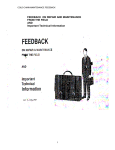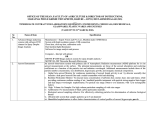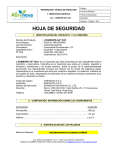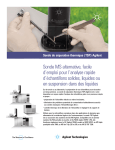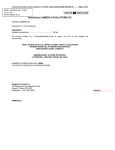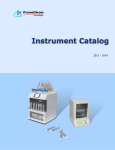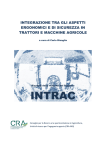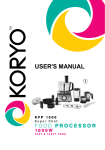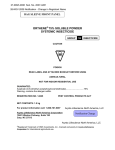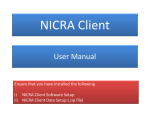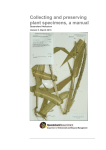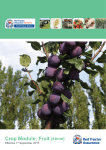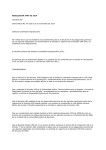Download HORTSAP USER-Manual - National Centre for Integrated Pest
Transcript
Implementation of electronic -pest (e-pest) surveillance Surveillance Plan: Cultivation of mango, pomegranate ,banana, santra, sweet orange and sapota is adversely affected due to damage by one or more of the above documented pests but a few pests such as Sigatoka leaf spot and thrips in banana, hoppers, thrips, powdery mildew and anthracnose in mango and bacterial blight, wilt, fruit borer and , thrips in pomegranate and thrips, psylla, fruit sucking moth and phytophthora in santra/sweet orange and bud borer, seed borer and phytophthora in sapota crop were considered most important leading to economic losses and force the farmers to make repetitive sprays. To change from the situation of repetitive sprays to Economic Threshold Level (ETL) based application of pesticides, constant watch is required on pest activity. It was made possible with the help of information technology that helped to develop an e- pest vigilance/ surveillance programme by recording pest activity data with the help of scouts and pest monitor employed by Department of Horticulture, Govt. of Maharashtra. The pest data recorded is fed in to the system and subsequently transferred to centralized server located at NCIPM, New Delhi. Consultative meeting of all the identified partners under CROPSAP (Horticulture) finalized the structure of pest surveillance plan,ETL’s and guidelines for pest scout/monitor were also framed. Observations were recorded on weekly basis as per plan (Table 1). Pest surveillance programme was implemented in twenty three districts of Maharashtra i.e. Sindhudurg, Raigarh, Ratnagiri, Thane, Aurangabad, Beed, Osmanabad for mango: Solapur, Nashik, Sangli, Ahmednagar, Aurangabad, Beed, Dhule, Satara for pomegranate and Jalgaon, Hingoli, Solapur, Nanded for banana: Akola, Amarawati ,Buldhana, Nagpur, Wardha, Washim for santra: Aurangabad, Beed, Jalana, Nanded for sweet orange covering 3,61,647 ha (Table 2). These data are archived, reviewed and approved by district horticultural officer and based on the extent of damage, pest advisories are issued by respective crop experts of MPKV, Rahuri, Dr. BSKKV, Dapoli, VNMKV, Parabhani and PDKV, Akola and disseminated to the farmers through SMS for timely action on part of the farmers by state department of Horticulture on the basis of Economic threshold levels (Table 3) available for the important pests as mentioned above. In this programme, NRC Pomegranate, Solapur, NRC Banana, Trichi, NRCC, Nagpur, Dr. BSKKV, Dapoli and MPKV, Rahuri, VNMKV, Parabhani and PDKV, Akola are co partners responsible for development of surveillance plan and issue of advisory. NCIPM, New Delhi is facilitating the development of software, GIS maps, data entry and overall coordination of the project activity. Table 1: Surveillance plan (observations on weekly basis) Day Monday Surveillance schedule of pest scouts & data entry operators (DEO) Two fixed orchards and two random orchards /village in two villages by one scout. Scouts would look for presence of pests and outbreaks for general reporting under pest alerts. Two fixed orchards and two random orchards /village in two villages by one scout Tuesday Wednesday Data entry operator (DEO) to enter data collected on previous two days + documentation of data (Geographical, Cropping System and Agronomic details ). Two fixed orchards and two random orchards /village in two villages by one scout Thursday Two fixed orchards and two random orchards /village in two villages by one scout Friday Data entry operator (DEO) to enter data collected on previous two days + documentation of Saturday data (Geographical, Cropping System and Agronomic details ).Issuing of timely advisories. No. of orchards 8 8 16 8 8 16 Table 2: Area of operation under e-pest surveillance for different crops (pest scout and pest monitor) Crops Pomegranate Banana Mango Santra Sweet Orange Sapota Total Number of districts covered Number of Talukas covered Covering Area (ha) 8 4 7 6 4 1 23 Districts 32 13 45 25 23 4 142 64,928 53,881 1,07,182 73,381 56,859 5,416 3,61,647 Table 3: Economic threshold levels (ETL) for various pests in HORTSAP crops as per recommendation of universities/NRC Crop Banana Mango Pomegranate Pest Sigatoka leaf spot Thrips Hoppers Thrips Powdery Mildew Anthracnose Bacterial blight Wilt Thrips Fruit Borer Santra/Sweet Orange Sapota Whiteflies and Black flies Psylla Thrips Leaf miner Mites Bark eating caterpiller Fruit sucking moth Phytophthora Bud Borer Seed Borer Phytophthora Recommended stage of the Spray Proposed ETL After appearance of yellow spots on lower leaves 0.1(10 spots/leaf) At flag leaf stage 10 Hopper/panicle/vegetative flush Immediately after appearance of thrips on inflorescences >10/panicle and appearance of scrapping symptoms on fruits. After appearance of incidence on panicles Score 2.1 or 1.1% fruit infestation 10 Score 1.25 on fruits After appearance of incidence on foliage/fruits/panicles Appearance on any plant part Appearance of single partial /completely wilted plant Wait and watch Curative sprays Wait and watch Curative sprays 5-10 nymphs 1 Score (Grade 1 or more) Appearance on any plant part Appearance of single partial/ completely wilted plant If fruit infestation is < 0 %. If fruit infestation is > 1% If fruit infestation is < 0 %. If fruit infestation is > 1% 5-10 nymphs 6 psylla/leaf 10 thrips per branch tapping 10% affected leaves ETL is 2 % infested fruits or 10% infested leaves Start spray if 10% trees are found infested 6 psylla/leaf 10 thrips per branch tapping 10% affected leaves ETL is 2 % infested fruits or 10% infested leaves Start spray if 10% trees are found infested Start the sprays if 10% fruits are found punctured due to this pest After appearance of incidence At bud stage Immatured fruit stage After appearance of incidence on fruits Start the sprays if 10% fruits are found punctured due to this pest 0.1 score 5% bud borer infestation 1% seed borer 1 score 1 Score The manual presents the procedure to be followed towards selection of orchards at village level besides methods to be adopted for recording of observation on pest using the data recording formats finalized. The details guide lines are presented crop wise as follows: Structure and maintenance of the e-pest surveillance software: Keeping in view the size of data and internet connectivity in remote areas of state, three tier architecture based system was designed comprising three major functional components viz. a database, data entry & transfer module and pest reporting & advisory module. The inter-connection and arrangement of these modules is shown in the adjacent depicted figure. Information flow chart of the system is mentioned below: Data collection Data entry Data verification Data transfer to centralized database Pest reporting & advisory issue Pest advisory dissemination The software is maintained at NCIPM server and data can be accessed using user Id and login password provided to selected and identified users. GUIDELINES TO PEST SCOUT (1) Banana Selection of Orchards & Trees: Two fixed orchards and two random orchards /village are selected by one scout who cover two villages per day. From each selected orchard, randomly 20 plants are selected, and on each selected plant, 15 leaves are observed randomly for recording observation for insect pests and diseases. Scout looks for presence of pests and outbreaks for general reporting under pest alerts. Observations on different pests are recorded in structured sheet prepared for scout as per procedure laid out below: Method of recording observation Banana Thrips: Select 20 plants during shooting stage and observe for rust thrips damage on the developing fingers. In each bunch, observations may be taken in 3 hands one each at top, middle and lower hands. In each hand, scoring may be carried out for 10 fingers at random. The thrips damage may be measured on 1-5 scale on the basis of extent of damage as described below: Thrips Score scale: 1 - Healthy 2 - 1-25% of fruits damaged 3 - 26-50% of fruits damaged 4 - 51-75% of fruits damaged 5 - 76 and above of fruits damaged Means score is calculated (Total No. of values / 20) and on this basis advisory is issued. Sigtoka leaf spot disease: The disease is scored in the scale given below on 15 leaves per plant. Sigtoka Disease Score: 0 - Nil 1- 1% of the leaf having spots or less than 10 spots 2- 2 to 5% of the leaf area affected 3- 6 to 15% of the leaf area affected 4- 16 to 33% of the leaf area affected 5 - 34 to 50% of the leaf area affected 6- > 50% of the leaf area affected Means score (Total No. of values/20x15) is calculated for issuing of advisory. Severity average score (Infection index) for sigatoka disease may also be calculated as below: Infection index = Ónb X 100 / (N -1) T Where, n = number of leaves in each grade, b = grade or nb= total grades of each plant N= number of grades used in the scale (7), T = total number of leaves scored It may be noted that missing leaf or dead leaf hanging down the pseudo stem i.e. when a leaf is missing or dead and hanging down the pseudo stem, it should not be included in the infection index calculations. Calculate the infection index for each plant at each growth stage i.e. vegetative, flowering/shooting and harvest stage. Crop conditions: It may be rated good (Number of hands/plant is 10-12 or number of leaf/plant is 15-20), medium (Number of hand /plant is 8-10 or number of leaves/plant is 10-15) and poor (Number of hands /plant is 6-8 or number of leaves/plant is 5-10 (2) Mango Selection of orchards and trees: The orchards are selected one each on hill slope/top and on plane for fixed and random survey. From each selected orchard, randomly 4 trees are selected, and on each selected trees, 5 shoots/ panicle are observed randomly for recording observation on pests and diseases. Two fixed orchards and two random orchards /village are selected by one scout who covers two villages per day. Method of recording observation: Observations for different pests are recorded in structured sheet which is prepared for the pest scout. Five shoots/panicles are selected per tree, one from each direction and centre of selected tree. Number of hoppers per panicle shall be counted. Observations on thrips population are recorded by tapping the shoots/ panicles on white paper and total number of thrips are counted. For assessing the potential damage caused by a pest, criteria for hoppers is based on number/panicle/ shoots whereas for thrips before fruit formation is also on the basis of number as for hoppers but after fruit formation, it is recorded on 0-4 scale. Total number of fruits from pea nut stage onwards are recorded per shoot/ panicle selected. Mango Hoppers: Weekly observation on number of both nymphs and adults are recorded on selected shoots or panicles. Mean hoppers per shoot/panicle is calculated (Total No. of values / 20). Mango Thrips: Total number of fruits from pea nut stage onwards are recorded per shoot/ panicle selected. Observations on thrips population are recorded by tapping the panicles on white paper. As the fruiting starts, damage due to thrips on fruits is assesed. On the basis of surface area of fruits damaged by thrips, the observed fruits is placed in 0-4 scale as details below. Mean thrips per shoot/panicle per plant (Total No. of values / 20). Thrip Scoring Scale 0 - healthy fruits 1- 1 to 25% fruit area damaged 2- 26 to 50% fruit area damaged 3- 51 to 75% fruit area damaged 4- 76% and above fruit area damaged % Percent thrip damage = Sum of all numerical rating ————————————————— x 100 No. of fruit observed x Maximum rating Powdery mildew and anthracnose: The same shoots/ panicles is observed for disease intensity. The disease intensity is score in zero to five scale. Rating Scale: 0 = No. intensity 1 =1 - 20% intensity 2 = 21 - 40% intensity 3 = 41 - 60% intensity 4 = 61-80% intensity 5 = 81-100% intensity Sum of all numerical rating PDI = ————————————————————— x 100 No. of shoot/panicles observed x Maximum rating Mean PDI of Powdery mildew and anthracnose =Total No. of values/20 Fruit fly: Four traps per ha are installed in the selected orchards and weekly count of the fruit fly trapped in each trap is taken. The trap is charged with methyl eugenol (3ml) every month. Crop condition: It may be recorded visually and rated as good if more than 50% of the tree is in flowering, average if 25-50 % of the tree is in flowering and poor if less than 25 % of the tree is in flowering. Fruit bearing: Observed the tree visually and if most of the panicles bear fruit means heavy, if 50 per cent of the panicle bears fruit it is optimum and if less than 50 % of the panicle bears fruit means average. Other pests: Record the name of other pests only. (3) Pomegranate Selection of orchards and trees: Two fixed orchards and two random orchards /village are selected by one scout who cover two villages per day. In each orchard, 50 trees are observed by selecting 5 trees at ten sites. Select orchard having at least one acre area and assigned fixed 1/2 and random 1/2. Prefer villages at 10 Km distance, however, adjoining village is also considered if it has at least 50 ha area. Write the name of village as mentioned in office records. Name and contact number of Grower to be noted for fixed plots only. Methods of observations: Observations on bacterial blight, wilt, thrips and fruit borer are recorded in structured sheet. Pick a zigzag route across the orchard so as to represent the entire orchard area, and inspect 5 plants each at 10 sites in an orchard for all diseases except wilt and 1plant at each site for insect pests, leaving border rows and plants. Bacterial Blight: Bacterial blight symptoms should be observed on all the units of a tree -such as leaves/stems/fruits-available at the time of survey. Note on leaves (L) symptoms should be observed only if fruits (F) are not available or fruits are disease free. Strike off L/F in the table, depending on the unit on which data is not recorded. On stems (S) symptoms should be observed always. A tree will be considered affected if blight is found on any unit on a tree. Write total affected trees out of 5 at each site in Column A. Severity Grade: For severity on leaves, stems and fruits observe 5 trees at each site. Move around the tree and observe leaves and fruits all search over the tree. Write the grade as per guidelines in the table on severity grades based on observation method in Column B for each unit and plant and average of all 5 in Column C. Mean score (L/F) = Total No. of values/10 x 5. For assessing bacterial blight cankers on stems & twigs, observe symptoms on main stems, branch and twigs and write the grade in Column B as per guidelines in table on severity grade. Mean score (Total No. of values/10 x 5). Wilt: Do not consider plants wilted due to water logging/water stress/breaking of stems. Count total no of plants in the orchard and total wilted (partial/complete) plants and write in Columns D and E, respectively. Also observe the roots and split stems (lower region just above ground) in few plants randomly and write the abbreviation depending upon the cause observed, more than one cause can be seen for same plant/site. Enter the abbreviation/s as given in the box in Column F. Percent Incidence: wilted plants in the orchard x 100/plants in the orchard. Guidelines for Severity Grade Bacterial Blight Severity grade to be allotted % severity 0 1 2 3 4 5 0 1-10 11-25 26-50 51-75 76-100 Observation method on different units Leaves and fruits Disease not seen Disease not easily visible, very few units/plant found diseased after careful Disease visible easily in each direction, but most (75%) of the units look healthy Both disease and healthy units are equally observed Disease seen very easily, with only some healthy units All most all units are diseased with few healthy units seen on careful search Stems (No. of cankers/tree) 0 1 2-3 4-6 7-10 >= 11 If grey / blue / brown discolouration of wood in split stem is observed write Cf, if the blackening of roots with rotting of tertiary or secondary roots is observed with/without white fungal growth write RRF, if small pin holes are observed on the surface of roots or split stems write SHB, if knots are observed on the roots generally fine roots, write N and if some other cause like some other insect/fungal damage is observed write O. Thrips: Twigs and fruits should be observed on top, middle and bottom portion of the plant. Note number of affected tips (AT) out of 40 young twig tips observed /site, 8 from each plant in four directions. Caclulate % affected twigs (AT/40*100) and enter in Columns G. Count number of fruits showing thrip symptoms out of 100 fruits observed per site (20/plant) and enter in Columns H. Percent Twig or fruit affected = Total No. of values /10. #Abbreviations for cause of wilt Abbr. Cause Cf Ceratocystis fimbriata RRF Root Rot Fungi SHB Shot hole borer N Root Knot Nematode O Others Fruit borer: Enter in Column I total numbers of bored fruits/100 fruits from 5 plants at each site, Note same 100 fruits observed for thrips can be observed. Percent fruit affected = Total No. of values / 100. Other Diseases/Insect Pests and their Incidence: While following zigzag route across the orchard for recording major diseases and insect pests also observe other diseases and insect pests mentioned in the proforma in Column J and check in Column K as: Nil for absence of disease and/or insect pest, Low for presence at a level which causes insignificant loss in quality/quantity (i.e. you may come across only 1or 2 out of 20 sites and that too upto 1-4% incidence/infestation on each infected plant). for the presence at a level which may cause economic losses (quality/quantity) if not monitored constantly and managed through IDPM strategies to reduce its population (i.e. you may come across the presence at 5-6 out of 20 sites with 5-10% incidence/infestation on each infected plant). Severe for presence at a level where it has crossed economic threshold and is causing qualitative/quantitative losses and warrants immediate attention and implementation of IDPM strategy (i.e. you may come across the presence at more than 10 out of 20 sites with 11-25% incidence/infestation on each infected plant). Any Other: If any other diseases or pests, apart from those mentioned above ,are seen, they should be mentioned. If unable to identify samples may be sent to the nearest SAU/ NRCP for identification and Pest monitor be alerted for confirming and taking further action. Av. No. of trees/ha: Observe the approximate plant to plant and row to row distance in meters (m) and write the number of trees against the distance in the table/Enquire the farmer. Stage of crop on the day of survey: Pomegranate production is taken through out the year in Maharashtra, hence the crop can be at rest/stress/defoliation/flowering/fruiting/ready for harvest at the time of survey, disease/insect pest situation also varies with crop stage, hence should check the crop stage and note. Orchard Sanitation: Check Poor if full of weeds and fallen plant debris, Good if the basin and rows are almost free from weeds and plant debris, however some weeds may be seen along the bunds and plant debris dumped near the orchard, Excellent if the orchard has no weeds and fallen debris in and around the orchard Crop condition: Note the plant growth and foliage depending on age of crop. Foliage: Check Good if sufficient healthy green foliage with normal expanded leaves is observed with proper plant canopy, Average if in general foliage is green but some foliage is yellow/distorted or bunched leaves/affected with diseases and pests and Poor if heavy incidence of diseases and insects observed or foliage is not green and showing poor nutrition status. Fruit bearing: Observe fruit bearing depending on age and canopy of plant. The optimum bearing for a good canopy is given in the table. For trees bearing fruits more than this check Heavy, for trees with optimum bearing check Optimum and for lower than optimum Check poor. Age Optimum no. of Fruit stage: If fruits have developed colour/on tapping the fruit you get metallic (yrs) fruits/tree 2 15-20 sound/arils are red and sweet to taste check ready for harvest otherwise check not 3 30-35 ready for harvest. 4 60-80 Fruit Size: Write the size depending on size of 70% fruits, if >70% fruits are above 400g check King size, if >= 5 100-120 350-400g check Large, if 250-300g check Medium and below 250g writ check Small. Fruit colour: Note fruit colour only if fruits are almost ready for harvest. The varieties Bhagawa/Arakta/Mridula/Ruby have red fruits and Ganesh has yellowish pink colour fruits. If the fruits have the normal varietal colour uniformly without any spots/scars check Excellent, if fruit colour deviates slightly from normal or has some scars/spots check Medium, if fruits have not developed normal varietal colour or have many spots or scars check Poor. Other Activities: Note down various activities of pruning, training, irrigation schedule, fertilizers and most common insecticides, fungicides, bactericides, bioformulations, botanicals etc used by the farmer in the schedule. Any other information relevant to the orchard performance (Good/bad) may be noted. (4) Santra (Nagpur Mandarin)/Sweet Orange (Mosambi) Selection of orchards and trees: Two fixed orchards and two random orchards/ village are selected by one scout who covers two villages per day. One village may be covered in the morning and another in the evening. In each orchard, 4 trees are observed by selecting one tree from each direction (E, S, W, and N). Select orchard having at least one acre area and assigned fixed ½ and random ½. Prefer villages at 10 Km distance, however, adjoining village is also considered if it has at least 50 ha area. Write the name of village as mentioned in office records. Name and number of grower to be noted for fixed plots only. Method of observations: Insects: Citrus Psylla: Weekly observation on number of citrus psylla per 10 cm shoot may be recorded on four selected shoots per tree, four each from E, S, W and N of the tree. Record observations on four trees in each selected orchard. While observing the pest population, both nymphs and adults of the pest may be taken into account and total number on 4 shoots (10 cm size) per tree need to be noted. Total number of shoots observed will be 16 per orchard. White fly and Black fly: Weekly observation on number of white fly and black fly (both nymphs and adults) per 5 leaves from each direction (E, S, W, N) of the tree. While observing the pest population, both nymphs and adults of the pest may be taken into account and the number per 5 leaves in one direction of the tree need to be noted. Total number (white fly/black fly) on 20 leaves per tree need to be recorded. Total number of leaves observed will be 80 per orchard. Leaf miner: Weekly observation on number of mined leaves per 5 leaves from each direction (E, S, W, N) of the tree may be recorded.. Record total number of mined leaves per 20 leaves per tree. Total number of leaves observed will be 80 per orchard. Thrips: To record the observations on thrips population one terminal branch from each direction (E, S, W, N) should be selected. Each selected branch should be tapped and number of thrips fallen should be recorded. From each tree 4 branches should be tapped and from one orchard there will be total 16 branches. Mites: Weekly observation on number of fruits or leaves as the case may be infested with mites per 5 leaves/fruits from each direction (E, S, W, N) of the tree may be recorded.. Record the total number of infested leaves/ fruits per 20 leaves/fruits per tree. Total number of leaves/fruits observed will be 80 per orchard. Fruit sucking moth: Move diagonally in the field and select 10 spots. At each spot collect total drop fruit and count the fruit damaged by fruit sucking moth on the basis of punctured fruits. Bark eating caterpillar: Observe 25 trees randomly from the orchards of the fixed plot and Random plot and count the number of infested trees due to the bark eating caterpillar. Diseases: Phytophthora: The percentage phytophthora incidence will be estimated by counting the number of trees infected with gummosis/ foot rot out of total trees in the orchard of one acre size. (5) Sapota Selection of orchards and trees: Two fixed orchards and two random orchards/ village are selected by one scout who covers two villages per day. One village may be covered in the morning and another in the evening. In each orchard, 4 trees are observed by selecting one tree from each direction (E, S, W, and N). Select orchard having at least one acre area and assigned fixed ½ and random ½. Prefer villages at 10 Km distance, however, adjoining village is also considered if it has at least 50 ha area. Write the name of village as mentioned in office records. Name and number of grower to be noted for fixed plots only. Method of observations: Insects: Sapota bud borer: Record weekly number of buds infested due the pest and total number of buds on ten shoot in each direction i.e. E, S, W and N of the tree. Observe four trees in each of the selected orchard. While observing the pest population, identify the symptoms of the bud borer by concentrating on the holes made by the pest .Total number of shoots observed will be 160 per orchard. Per cent bud damage will be worked out ETL will be based on the per cent bud damaged. Sapota seed borer: Observe the total number of harvested fruits on the daily basis from the orchard and from the total harvested fruit record the number of fruits damaged due to the seed borer. Add up the data for all the five days (Monday to Friday) and record it into the data sheet on Saturday. Phytophothera diseases: Observe 10 shoot in each direction of the tree for the diseases. Grade the disease intensity on each shoot on the 0-4 scale as follow Rating Scale: 0 = No. incidence. 1 =1 - 20% incidence 2 = 21 - 40% incidence 3 = 41 - 60% incidence 4 = 61 -100% incidence Percent incidence will be calculated by following formula Sum of all numerical rating PDI = ---------------------------------------------------- x100 No. of shoot observed x Maximum rating GUIDE LINE TO PEST MONITOR Guide lines for selecting village/orchards/tree/plants and methods of observation are same as laid out for pest scout except pest monitor shall also make roving survey for all the three crops, select five orchards per day randomly and record observations in the structured sheet for Banana Mango and pomegranate. Digitization of such data on a centralized server enable the pest managers to view the pest activity without loss of time and pass on the pest advisory. In order to facilitate the pest monitor about the rating and extent of pest damage caused due to various pests in each crop, guidelines are issued which are given in Table 4-6. He also visits the orchards, wherever he comes to know about the sudden outbreak of pest activity and immediately report the incidence to pest approval officer. He is also responsible for supervising the work of pest scout to establish the truthfulness and accuracy of data. Table 4: Guidelines for Pest Monitors for rating the intensity of pest damage (Banana) Sr. No. 1. 2. Pest/Disease Banana leaf spot disease Banana thrips Crop stage Vegetative stage Low 0.1 to 5% leaf area infected Medium 6 to 10 % leaf area infected High > 10% leaf area infected Flag leaf or just shooting stage Opening of hands 10 to15 thrips/bract 16 to 20 thrips / bract > 21 thrips/bract 1.1%fruit infestaion 1.1% to 10 % fruit infestation > 10% fruit infestation Table 5: Guidelines for Pest Monitors for rating the intensity of pest damage (Mango) Sr. No. 1. 2. Pest/Disease Mango hopper Mango thrips 3. 4. Powdery mildew Anthracnose Crop stage Flowering flush Flowering flush Peanut marble stage fruits Flowering flush Flowering vegetative flush Fruit Low 1 to 5 hopper/panicle 1 to 5 thrips/panicle 1.25% incidence 1 to 25% incidence 1 to 5% incidence 1 to 5% incidence Medium 6 to 10 hopper/panicle 6 to 10 thrips/panicle 1.25% to 10% incidence 26 to 50% incidence 6 to 10% incidence 6 to 10% incidence High > 10 hoppers/ panicle > 10 thrips/ panicle > 10% incidence > 50% incidence > 10% incidence > 10% incidence Table 6: Guidelines for Pest Monitors for rating the intensity of pest damage (Pomegranate) Sr. No. 1. 2. 3. 4. Pest/Disease Crop stage Pomegranate incidence Bacterial Blight Vegetative/ flowering Pomegranate Wilt Pomegranate Thrips Any stage Pomegranate Fruit borer Fruit Bearing New flush / tender twigs / fruits Fruits Low Medium High Up to 10 % incidence on any part with average severity grade up to 1 Up to 5% incidence with average severity grade up to 1 Up to 5% incidence 11 to 20% incidence on any par t with average severity grade >1 to 2 6 - 10% incidence with average severity grade >1- 2 More than 20% incidence on any par t with average severity grade >2 to 5 More than 10% incidence with average severity grade >2-5 6 - 10% incidence More than 10% incidence 1 to 5% infestation 6 to 10% infestation More than 10% infestation 1to 5% infestation 6 to 10% infestation More than 10% infestation PEST MANAGEMENT ADVISORY Based on the recommendation of NRC and University, the two types of pest advisory were issued for all the three crops. The details of advisory is given cropwise in the pages to follow. Detailed form of advisory is available on NCIPM website and is disseminated to villages through field staff of state agriculture department and also popularized through radio / bulletin. The short form of advisory is disseminated through SMS to progressive farmers. 1. Banana S.N. 1. Situation Initiation of yellow spots Advisory Spray Carbendazim 50 WP at 0.1% 2. Spots turns brown colour Spray with Propiconazole 0.05% 3. The spots further increase in size, intermingled with each other forming large dry leaves(gray spots) More than 4-5 no of leaves infected Carbendezim 0.5% (0.5 g/l) + Mineral oil 1% 5. As disease intensity increases 6. Flag leaf stage or just shooting stage (observe for thrips) Remove infected part of the leaves and repeat the spray with above mention fungicides alternatively Spray with acetamiprid 20sp at 0.0025% or Verticillium lecanii (2x108 CFU/g) 3g/l+ Sticker 1ml/l or NSKE 5% 7. Opening of all hands (observe for thrips) 4. Remove infected part of the leaves and spray with Propiconazole 0.05% (0.5 ml/l) + Mineral oil 1% Spray with acetamiprid 20sp at 0.0025% or Verticillium lecanii (2x108 CFU/g) 3g/l+ Sticker 1ml/l or NSKE 5% Detailed Advisory As soon as the yellow small spots observed on the lower leaves of the plant spraying with Carbendazim 50 WP at 0.1% i.e. 1g/l + 1ml The colour of the spot changed yellow to brown spray with Propiconazole 0.05% 1ml/l+ sticker 1ml/l of water. The spots further increase in size, intermingled with each other forming large gray spots spray each other forming large with Carbendezim 0.5% (0.5 g/l) + Mineral oil 1% (10ml/l) As large area of leaves were infected the photosynthesis will be affected, to keep maximum no of functional leaves remove only infected part of the leaves and spray with Propiconazole 0.05% (0.5 ml/l) + Mineral oil 1% (10ml/l) Remove infected part of the leaves and repeat the spray with above mention fungicides alternatively Observe the fruit infestation by egg laying on immature fruits feeling pimple like structure at oviposition site. Record percent fruit infestation 10% with 10-15 thrips/bract. Spray with acetamiprid 20sp at 0.0025% or Verticillium lecanii (2x108 CFU/g) 3g/l+ Sticker 1ml/l or NSKE 5% Observe the fruit infestation by egg laying on immature fruits feeling pimple like structure at oviposition site. Record percent fruit infestation 10% with 10-15 thrips/bract. Spray with acetamiprid 20sp at 0.0025% or Verticillium lecanii (2x108 CFU/g) 3g/l+ Sticker 1ml/l or NSKE 5% 2. Mango Sr. No. 1. 2. 3. 4. 5. 6. 7. 8. 9. 10. Situation Short Advisory Detailed Advisory Egg laying site and curling of leaves. Nymphs of hopper on panicles at early stage. Honey dew excretion due to hopper observed on panicles and foliage. Spray Quinalphos 25 EC at 0.05% or Phozalone 35 EC at 0.05% Spray Imidachloprid 17.8 SL at 0.005 % or Thiamethoxam 25 WG at 0.0025 % Honey dew excretion due to hopper and growth of sooty mould Brown streaks on panicle rachis due to thrips Spray Chlothianidin 50 WDG at 0.006% Scrapping injury on fruits rind result in development of brown spot Powdery growth of powdery mildew on panicles Powdery growth of powdery mildew on panicles rachis and fruit stalk Powdery growth of powdery mildew on all the panicle parts. Black/Brown spot on panicles rachis and fruit of all stages due to Anthracnose. Spray Spinosad 45 SL at 0.0112 % or Thiamethoxam 25 WG at 0.005% Spray Sulphur 80 WP at 0.2 % Observe the egg laying site on veins of leaves and also on panicles. Record the nymphs population, if it is 1 to 5 spray Quinalphos 25 EC at 0.05% i.e. 20 ml./10 lit. or Phozalone 35 EC at 0.05 % i.e. 15 ml./10 lit. Honey dew excretion is noticed on foliage, panicles and various stages of hoppers in the range of 5 to 10/panicles is observed spray Imidachloprid 17.8 SL at 0.005 % i.e. 3 ml./10 lit. or Thiamethoxam 25 WG at 0.0025 % i.e. 1 gm/10 lit. Honey dew excretion on foliage, panicles and fruits, blacking due to black sooty mould and number of hopper more than 10/panicles spray Chlothianidin 50 WDG at 0.006 % i.e. 1.2 gm/10 lit. Observe the thrips population by tapping panicles on white papers. Thrips population exceed more than 10/panicles spray Phozalone 35 EC at 0.05 % i.e. 15 ml./10 lit or Diamethoate 30 EC at 0.03 % i.e. 10 ml/10 lit. Observed the thrips on fruit at pea nut stage onwards. The rind surface is rough brown due to scrapping injury. Sprays Spinosad 45 SL at 0.0112% i. e. 2.5 ml./ 10 lit. or Thiamethoxam at 0.005 % i. e. 2 gm/10 lit. Powdery growth noticed on panicles. Spray Sulphur 80 WP at 0.2% concentration along with insecticidal sprays. Powdery growth noticed on panicle rachis and fruit stock spray Carbendazim 50 WP at 0.1% along with insecticidal sprays. Puncture injury due to fruit fly, maggots in ripped fallen fruits, fruit fly population in traps. Spray Phozalone 35 EC at 0.05 % or Diamethoate 30 EC at 0.03 % Spray Carbendazim 50 WP at 0.1 % Spray Hexaconazole 5 EC at 0.05 %. Spray Carbendazim 50 WP at 0.1% or Thiophenate methyl 70 WP at 0.1% or Propineb 70 WP at 0.2% Install fruit fly trap at 4 trap/ha. Powdery growth covered all the parts of panicles. Flowers and fruits drops, spray Hexaconazole 5 EC at 0.05 %. Brown to black spot or blightening symptoms on rachis and fruits due to unseasonal rainfall or heavy dew fall spray Carbendazim 50 WP at 0.1% or Thiophenate methyl 70 WP at 0.1% or Propineb 70 WP at 0.2 % Puncture injury observed on infested fruits at maturity stage, maggots observed in ripped fallen fruits, fruit fly population noticed in traps install fruit fly trap at 4 trap/ha. 3. Pomegranate Disease Bacterial Blight Situation Blackish brown spots due to bacterial blight infection seen in traces on any plant part Short Advisory Spray Streptocycline (5g/10 l) /2-bromo, 2-nitro propane-1, 3-diol (Bronopol) @ 5g/10 l mixed with copper based formulations like copper oxychloride or copper hydroxide (20-25g/ 10 l) altered with Bordeaux mixture (0.5- 1%) Blackish brown spots on fruits with or without splitting due to bacterial blight infection and stem infections around the nodes Remove and burn all infected fruits/stems followed by sprays of Streptocycline (5g/10 l) /Bronopol @ 5g/10 l mixed with copper based formulations like copper oxychloride or copper hydroxide (20-25g/ 10 l) altered with Bordeaux mixture (0.5- 1%) Detailed Advisory During crop season spray Bordeaux mixture (0.5% except 1% just after pruning), altered with streptocycline (5g/10 l) /2-bromo, 2-nitro propane-1, 3-diol (Bronopol) @ 5g/10 l mixed with copper based formulations like copper oxychloride or copper hydroxide (20-25g/ 10 l). Depending on fungal problems present in the orchard Copper based formulations may be replaced with appropriate fungicides. During rest period after harvest take prophylactic sprays of Bordeaux mixture (1%) altered with streptocycline (2.5 g/ 10 litres)/Bronopol @ 5g/10 litres mixed with copper based formulations like copper oxychloride or copper hydroxide (20-25g/ 10 l) at 15-20 days intervals Follow all sanitation measures: • Remove fallen plant debris and burn them- do not dump them in or near orchards nor throw them in irrigation channels. • Drench bleaching powder (a.i. 33% Cl) every 3 months @ 25 Kg/1000 litre water/ha on ground below the canopy • Disinfect pruning tools – secateurs etc after handling each plant with sodium hypochlorite (2.5%) and keep orchard free from weeds. 1. Change crop season; Avoid mrig bahar (rainy season) crop and shift to hasta bahar crop for at least 4-5 few years. 2. Follow all sanitation measures as given above 3. Practice proper pruning and training • If stem infections are severe practice heavy pruning immediately after harvest and remove all stems with blight infection. • Prune about 2-3" below the infected area. • Cankers, should be preferably removed by pruning; if not removed should be scooped out, till normal wood appears and then pasted/painted. Apply Bordeaux paste (10%) to the cut ends after pruning and to scooped cankers. Oil based pastes [COC paint made by mixing 500g COC + 1 l linseed oil or Chaubatia paste prepared by mixing 1kg red lead(non setting grade) + 1kg copper carbonate + 1.25 l linseed oil] are preferred for pasting during rainy seasons. • Severely infected plant must be uprooted burnt and replaced with new disease free plant or cut from base 2-3 inches above ground level. New well growing sprouts should be trained for new disease free plant. 4. Follow spray schedule during crop season and rest period as above 5. Observe all precautions: • Take only need based sprays at recommended doses, too many sprays increase the disease. • Before starting any spray remove and burn all affected fruits. • Insecticides, fungicides or micronutrient sprays required should be combined with bactericidal sprays depending on compatibility to reduce number of sprays. • Wilt Yellowing/drooping/ drying of 1 or more branches in a plant/s or entire plant/s due to wilt First Ascertain the cause/s. • If fungal pathogens and shot hole borer, immediately drench soil with chlorpyriphos 20EC (2.5ml/l to During crop period soon after the rains -when plant surfaces dry up- additional spray with a bactericide should be taken without fail. • Always (rains or no rains) mix good quality nonionic spreader sticker with sprays except with Bordeaux mixture. • Bordeaux mixture should always be prepared fresh and used on the same day • Provide balanced nutrition to plants, follow rest period of 3-4 months and take only 1 crop in a year to improve plant vigour and resistance. 1. On observing first symptoms of wilt first ascertain the cause/s. If wilt is due to fungal pathogens in the orchard immediately drench soil with chlorpyriphos 20EC (2.5ml/l to 4.0ml.l) + carbendazim 50WP (2.0g/l) or propiconazole 25EC (2ml/l) use 5-8 l solution/plant. Also drench at least 4.0ml/l) + carbendazim 50WP (2.0g/l) or propiconazole 25EC (2ml/l), • If root knot nematodes are associated apply phorate 10G @1020g/plant or carbofuran 3G @ 20-40g/plant in the plant basin. Thrips . Leaf curling; tender tip drying; scrapping marks on buds, flowers and fruits due to thrips Spray thiamethoxam 25 WG @ 3 gm/ 10 lit. or acetamiprid 20 SP @ 3 gm/ 10 lit. or Acephate 75 SP 10 gm/10 lit. from new leaf initiation to final harvest subjected to the presence of thrips. 2-3 healthy plants on all the four sides around the infected plant/s, repeat the drenching 3-4 times at 20 days interval. 2. For controlling shot hole borer (Xyleborus spp.) which is associated with wilt disease, 10 litres preparation containing red soil (4kg) + Lindane (25g) + Chlorpyriphos 20EC (20ml) + Copper oxychloride (25 g) needs to be applied on plant base up to 2 ft. from second year onwards. To control stem borer, inject in the holes on the trunk with DDVP 2-3 ml and plug the holes with mud. 3. Wilt due to root knot nematodes can be managed with soil application of phorate 10G @10- 20g/plant or carbofuran 3G @ 20-40g/plant in the plant basin, in a ring near root zone and cover it with soil. Drenching with azadirachtin (1% ) @ 2ml/l is also recommended. Plant Tagetes erecta (African marigold) between plant to plant space in a row, or in a ring, on the border of plant basin. For effective results these should be grown for more than 4-5 month. 4. Once disease is detected in the orchard, dig about 3-4 feet long trench between the wilted and healthy plant/s. The partially wilt affected plant/s should be treated with a systemic fungicide and dead plants should be removed and burnt, they should not be kept dumped in the orchard for firewood. While removing the wilted plants from the orchard for burning, protect the entire root zone with cover. 5.Pruning tools should be disinfected and cut ends painted with fungicidal oil based paints. Pruning should be avoided during spring to summer and done in winter months. Affected plants within the buffer zone should be treated with a systemic fungicide; neighboring asymptomatic apparently healthy plants should also be treated with appropriate systemic fungicides. Plants with more than 30% canopy loss should not be treated, they should be uprooted and burnt. • Do not plant the seedlings which tips are dried or leaves are curled and deformed. • Do not intercultivate alternate host crops like chilly, onion, garlic, brinjal and tomato in Pomegranate. • Fruit Borer Bored holes on buds, flowers and fruits due to fruit borer Spray deltamethrin 2.8 EC @ 1.5 ml/l or methomyl 40 SP @ 1.0 g/l or azadirachtin 1500 ppm @ 3.0 ml/l at 15 days intervals from initiation of flowering up to harvesting subjected to the presence of fruit borer. • • • Pluck the tender shoots as and when it appears on plant from leaf shedding to final harvest. If the pomegranate acreage is 1 to 2 ha, fruits can be wrapped with butter paper for hindering the egg laying by butterflies as well as boring by larva. Do not plant alternate host crops like guava, sapota, aonla and tamarind in the pomegranate orchard. The affected fruits should be collected and destroyed continuously up to final harvest. 4. Citrus /Santra (Nagpur Mandarin)/Sweet Orange Sr. No. 1. Situation Presence of nymphs of whitelies and blackflies, honey dew excretion and development of sooty mould 2. Presence of nymphs of psylla on young flush 3. Upward curling of leaf margin and presence of mined leaves 4. mottling of the leaves and presence of whitish silvery ring around the fruit neck. 5. Presence of rigid and curling of leaves and brown-reddish black spots on the fruit surface 6. Presence of fecal matter and wooden frass hanging on the tree trunk and branches Presence of fallen punctured fruits in the orchard 7 Short Advisory Spray imidacloprid 17.8 Sl @ 0.5 ml or acephate 75 WP @ 1.25 g or phosalone 35 EC @ 1.5 ml or dimethoate 30 EC @ 2 ml or abamectin 1.8 EC @ 0.42 ml 0r novaluron 10 EC @ 0.79 ml/l of water. Detailed Advisory Nymphs present on leaves secrtes honey dew on which sooty mould grows widly that leads to fungal manifestation locally called as Kolshi. If 5-10 nymphs/ leaf are present then spray imidacloprid 17.8 Sl @ 0.5 ml or acephate 75 WP @ 1.25 g or phosalone 35 EC @ 1.5 ml or dimethoate 30 EC @ 2 ml or abamectin 1.8 EC @ 0.42 ml 0r novaluron 10 EC @ 0.79 ml/l of water.@ 10 ml/l of water. Spray quinalphos 25 EC @ 1ml or Observe psylla nymphs (6-10 nymphs/ 10 cm shoot) after the starting abamectin 1.8 EC @ 0.42 ml or novaluron of new flush i.e February-March in Ambia and June-July in Mrig 10 EC @ 0.55 ml/l of water flush. Spray quinalphos 25 EC @ 1ml or abamectin 1.8 EC @ 0.42 ml or novaluron 10 EC @ 0.55 ml/l of water when infestation is noticed. If required, second spray of any of the above insecticides should be given after 15 days. Spray of neem oil 5 ml or imidacloprid Observe the upward curling of leaf margin and presence of mined 17.8 SL @ 0.5 ml or phosalone 35 EC @ leaves (10 % affected leaves). Foliar spray of neem oil 5 ml or 1.5 ml or fenvalerate 20 EC @ 1 ml or imidacloprid 17.8 SL @ 0.5 ml or phosalone 35 EC @ 1.5 ml or abamectin 1.8 EC @ 0.32 ml or spinosad fenvalerate 20 EC @ 1 ml or abamectin 1.8 EC @ 0.32 ml or spinosad 45 SC @ 0.34 ml or novaluron @ 0.87 ml 45 SC @ 0.34 ml or novaluron @ 0.87 ml /l of water by directing at /l of water. the new flush. Spray dimethoate 30 EC @ 2 ml or Observe the thrips population by tapping panicles on white papers. acephate 75 WP @ 1.25 g or phosalone Thrips population exceed more than 10/branch spray dimethoate 30 35 EC @ 1.5 ml/l of water EC @ 2 ml or acephate 75 WP @ 1.25 g or phosalone 35 EC @ 1.5 ml/l of water at bud burst stage and on berries. Spray wettable sulfur 85 DP @ 3 g or Observe the mite population on leaves as well as on fruits, if 2% dicofol 18.5 EC @ 2ml or propargite 57 infested fruits or 10% infested leaves are observed foliar application of EC @ 1 ml or abamectin 1.8 EC @ 0.37 wettable sulfur 85 DP @ 3 g or dicofol 18.5 EC @ 2ml or propargite or ethion 50 EC @ 1 ml/l water 57 EC @ 1 ml or abamectin 1.8 EC @ 0.37 or ethion 50 EC @ 1 ml/l water. Application of 5-10 ml of dichlorvos 1% Presence of fecal matter and wooden frass hanging on the tree trunk into the tunnel and branches are symbolic of larval presence inside the tunnel. If 10% trees are found infested inject 5-10 ml of dichlorvos 1% into the tunnel and cover with cotton wad. Spray neem oil 1% or malathion 50 EC @ If 105 fruits are found punctured due to pest, foliar application of 2ml or carbaryl 50 WP @ 2 g/l water. neem oil 1% or malathion 50 EC @ 2ml or carbaryl 50 WP @ 2 g/l water at 10-15 days interval during fruit maturity till harvest 5. Sapota Pest Bud borer (Anarsia achrasella) Seed borer (Trymalitis mxargarias Meyrick) Fruit drop Situation The larva bores through the upper tapering part of the flower bud and eats up the inner content leading to no flower setting or retention. The infested buds shows milky appearance and presence of larval excreta. The larva also cuts the margin and leaf lamina of the newly emerged leaves. The adult lays eggs on outer rough surface of the fruits. The just hatched larvae makes holes on the surface of the fruits and make galleries through the fruit pulp. If finally reaches to the seed where it bores through the seed coat and finally damages the kernel of the fruit seed. After appearance of incidence on feuits Short advisory Spray Emamectin benzoate 5SG @ 0.45 g/lit or Deltamethrin 2.8 EC @ 1 ml/lit or Lambdacyhalothrin 5EC @ 1ml/lit or Profenofos 40EC@1ml/lit. Spray of Profenofos 40EC@1ml/lit orDeltamethrin 2.8 EC @ (0.003%) 1ml/lit or Lambdacyhalothrin 5EC @ 1ml/lit or Indoxacarb 14.5SC @ (0.0072%) or Novaluron 10 EC @ (0.005%) or Detailed advisory Observe the bud boring insect spray Emamectin benzoate 5SG @ 0.45 g/lit or Deltamethrin 2.8 EC @ 1 ml/lit or Lambdacyhalothrin 5EC @ 1ml/lit or Profenofos 40EC@1ml/lit. the precaution should be taken that there should not be immediate repetition of any insecticides in the subsequent spray. All mature fruits should be harvested before each spray. Observe the seed borer and spray Profenofos 40EC @1ml/lit or Deltamethrin 2.8 EC @ 1 ml/lit or Lambdacyhalothrin 5EC @ 1ml/lit. or Indoxacrb 14.5SC @ 0.5ml/lit or Novaluron 10EC@ 0.5ml/lit Data Sheets 1. Banana SURVEY PROFORMA FOR BANANA DISEASES AND INSECT PEST IN MAHARASHTRA SCOUT PROFORMA Date of Survey: ………………….Orchard Type: Fixed1 / Fixed 2/ Random 1/ Random 2 --------- Plantation Area:……………….Name of Grower: -----------------Contact Number: ………………Village Name:………………Taluka Name: …………………District Name:………………….. Variety Name: -----------------------Spacing followed: --------------------------- Crop Condition: Good /Medium/Poor Crop Stage: Vegetative/Flowering/Bunch Maturing/Harvest Stage --------------------- Spray undertaken: a) Fungicide Name: ------------------ b) Dosage followed ----------------- c) No. of sprays ----------- d) Interval followed ---------Intercultural operations followed including removal of dried leaf Plant No 1 2 3 4 5 6 7 8 9 10 11 12 13 14 15 16 17 18 19 20 Pest Thrips population (Score scale) Leaf no Plant. No. 1 2 3 4 5 6 7 8 9 10 11 12 13 14 15 16 17 18 19 20 1 2 3 4 5 6 7 8 9 10 11 12 13 14 15 Total grade No of green leaves SURVEY PROFORMA FOR BANANA DISEASES AND INSECT PEST IN MAHARASHTRA MONITOR PROFORMA Date of Survey: ………………….Orchard Type: Random 1/ Random 2 --------- Plantation Area:……………….Name of Grower: ----------------Contact Number: ………………Village Name:………………Taluka Name: …………………District Name:………………….. Variety Name: -----------------------Spacing followed: --------------------------- Crop Condition: Good /Medium/Poor Crop Stage: Vegetative/Flowering/Bunch Maturing/Harvest Stage --------------------- Spray undertaken: a) Fungicide Name: ------------------ b) Dosage followed ----------------- c) No. of sprays ----------- d) Interval followed ---------Intercultural operations followed including removal of dried leaf Plant No 1 2 3 4 5 6 7 8 9 10 11 12 13 14 15 16 17 18 19 20 Pest Thrips population (Score scale) Leaf No Plant. No. 1 2 3 4 5 6 7 8 9 10 11 12 13 14 15 16 17 18 19 20 1 2 3 4 5 6 7 8 9 10 11 12 13 14 15 Total grade No of green leaves 2. Mango SURVEY PROFORMA FOR MANGO DISEASES AND INSECT PEST IN MAHARASHTRA SCOUT PROFORMA Date of Survey : ………. Orchard Type : Fixed1 / Fixed 2/ Random 1/ Random 2 Orchard area:……………….. Name of Grower :………… Contact Number : ………..No. of trees/ha. : …………..Village Name……………Taluka Name : …… ……………… District Name :………………….. Mango Variety : Alphonso/Kesar/ Ratna/ Pairi/ Goa Mankur / Local Crop condition : Flowering : Good / Average/Poor Crop stage : …………Fruit Bearing : Heavy/ Optimum/ Poor Shoot/Pa Hopper nicle No. Plant 1 Plant 2 Plant 3 Plant 4 1 2 3 4 5 1 2 3 4 5 1 2 3 4 5 1 2 3 4 5 Thrips on fruits No. of Fruits Damaged Thrips No. Of Fruits 0 1 2 3 4 Powdery Anthracnose intensity Mildew intensity Data Sheet Fruit Fly Trap Fly No. No. 1 2 3 4 SURVEY PROFORMA FOR MANGO DISEASES AND INSECT PEST IN MAHARASHTRA MONITOR PROFORMA Date of Survey : ………. Orchard Type : Random 1/ Random 2 Orchard area:……………….. Name of Grower :………… Contact Number : ………..No. of trees/ha. : …………..Village Name……………Taluka Name : …… ……………… District Name :………………….. Mango Variety : Alphonso/Kesar/ Ratna/ Pairi/ Goa Mankur / Local Crop condition : Flowering : Good / Average/Poor Crop stage : …………Fruit Bearing : Heavy/ Optimum/ Poor Data Sheet Shoot/Pa Hopper nicle No. Plant 1 Plant 2 Plant 3 Plant 4 1 2 3 4 5 1 2 3 4 5 1 2 3 4 5 1 2 3 4 5 Thrips on fruits No. of Fruits Damaged Thrips No. Of Fruits 0 1 2 3 4 Powdery Anthracnose intensity Mildew intensity Fruit Fly Trap Fly No. No. 1 2 3 4 3. Pomegranate SURVEY PROFORMA FOR POMEGRANATE DISEASES AND INSECT PESTS IN MAHARASHTR SCOUT PROFORMA Date of Survey:……………………… Orchard Type: Fixed 1/ Fixed 2/Random 1/Random 2 Orchard area: .................. Contact Number(for fixed plots)…… Name of Grower:………………………………. No. of trees/ha: ............ Village Name:............................ Taluka Name:.............................. District Name:.............................. Pomegranate Variety: Bhagawa/Ganesh/Arakta/Mridula/any other Orchard Sanitation : Poor/Good/Excellent) Stage of crop on the day of survey: Rest/Stress/Defoliation/Flowering/Fruiting/Ready for harvest Crop condition: Foliage (Good/Average/Poor) Fruit bearing (Heavy/Optimum/Poor) Fruit stage Ready/Not Ready for harvest Fruit Size (King Size/Large/Medium/small) Fruit colour (Excellent/Medium/Poor) Site No Total no. of trees affected out of 5 A Bacterial Blight *Severity Grade (0-5) on leaf (L), Stem (S), Fruit (F) Unit Plant Number Average Grade 1 1 2 3 4 5 6 7 8 9 10 L/F S L/F S L/F S L/F S L/F S L/F S L/F S L/F S L/F S L/F S 2 B. 3 Thrips Pl. No . % Affected Twigs C 4 5 G 1 2 3 4 5 6 7 8 9 10 % Affected fruits Fruit Borer Pl. No. No. of Bored Fruits out of 100 H I 1 2 3 4 5 6 7 8 9 10 S. No. 1 2 3 4 5 6 7 Other Diseases/Insect Pests Incidence Diseases/Insect Pests Severity Rating J K Cercospora Fruit spot Nil/Low/Moderate/Severe Fruit Scab Nil/Low/Moderate/Severe Colletotrichum fruit Nil/Low/Moderate/Severe rot Mites Nil/Low/Moderate/Severe Fruit sucking moth Nil/Low/Moderate/Severe Stem/Shot hole borer Nil/Low/Moderate/Severe Any other Nil/Low/Moderate/Severe Wilt Total Plants Total wilted plants D # Tick(√) the Major causes E Cf RRF F SHB N O ……………………………………………………… Collected by Name and Signature of Scout with date …………………….……………………………… Data Verified by Name and Signature of Pest Monitor with date Other Activities Pruning After harvesting/Before flower regulation Training (No.of main stems) : 1/2/3/4/>4 Irrigation (quantity of water/plant) ….. l/day Fertilizers Used (Dose/plant and source) FYM ……………..……................................................................................., N…..........................................................................…………………… …..., P……………................................................................................…… …….., K…………………..........................................................................…… .….., Micronutrients………………….............................................……… ……….. ................................................................................................................. ...... Spray schedule Daily/after 2-3 days/ after 5-7 days / after 10-15 days Major Pesticides used with dose Any other essential information …………………….………………………………………….. Data Uploaded by …………………………………………………………… Name and Signature of Data Entry Operator with Date and Time Counter Signed by Name and Signature with Date and Time 4. Santra (Nagpur Mandrin)/Sweet Orange (Mosambi) SURVEY PROFORMA FOR NAGPUR MANDARIN/SWEET ORANGE DISEASES AND INSECT PEST IN MAHARASHHTRA SCOUT PROFORMA Orchard Type: Fixed1/Fixed2/ Random1/ Random2 Orchard area: Cropping season during observation : Ambia (Jan-Feb flowering)/ Mrig (June-July flowering)/ Hasta (OctoberNovember flowering) Contact Number: No. of trees/Acre/ Orchard: Taluka Name: District Name: Fruit Bearing : Heavy/ Optimum/ Poor Weather parameters: Temperature (max-min), rainfall (mm) & humidity Date of Survey: Cultivar: Nagpur mandarin (santra)/ sweet orange (mosambi) Name of Grower: Village Name: Crop stage: Flowering/ Fruitlet/ Fruit maturity/ Preharvest (morning and evening) in meteorological weeks Tree No. Citrus psylla population/ 10 cm shoot East South West North East Whitefly population/ 5 leaves South West North East Blackfly population/ 5 leaves South West North Leaf miner (mined leaves/5 leaves) East South West North 1 2 3 4 Mite ( infested leaves/fruits per 5 leaves/fruits) Thrips population (nos./ branch tapping) Tree No. East Sout h West 1 2 3 4 F L F L F Bark eating caterpillar North East L Fruit sucking moth L F Sout h West Nort h Fruits punctured/ 10 spots Total fruits/ 10 spots No. of trees infested/ 25 trees Phytophthora gummosis/ root, collar or foot rot & brown rot in fruits incidence % Trees infected Total trees SURVEY PROFORMA FOR NAGPUR MANDARIN/SWEET ORANGE DISEASES AND INSECT PEST IN MAHARASHHTRA MONITOR PROFORMA Orchard Type: Random1/ Random2 Orchard area: Cropping season during observation : Ambia (Jan-Feb flowering)/ Mrig (June-July flowering)/ Hasta (OctoberNovember flowering) Contact Number: No. of trees/Acre/ Orchard: Taluka Name: District Name: Fruit Bearing : Heavy/ Optimum/ Poor Weather parameters: Temperature (max-min), rainfall (mm) & humidity Date of Survey: Cultivar: Nagpur mandarin (santra)/ sweet orange (mosambi) Name of Grower: Village Name: Crop stage: Flowering/ Fruitlet/ Fruit maturity/ Preharvest (morning and evening) in meteorological weeks Tree No. Citrus psylla population/ 10 cm shoot East South West North East Whitefly population/ 5 leaves South West North East Blackfly population/ 5 leaves South West North Leaf miner (mined leaves/5 leaves) East South West North 1 2 3 4 Mite ( infested leaves/fruits per 5 leaves/fruits) Thrips population (nos./ branch tapping) Tree No. East Sout h West 1 2 3 4 F L F L F Bark eating caterpillar North East L Fruit sucking moth L F Sout h West Nort h Fruits punctured/ 10 spots Total fruits/ 10 spots No. of trees infested/ 25 trees Phytophthora gummosis/ root, collar or foot rot & brown rot in fruits incidence % Trees infected Total trees 5. Sapota SURVEY PROFORMA FOR SAPOTA DISEASES AND INSECT PEST IN MAHARASHTRA SCOUT PROFORMA Date of Survey : …………………. Orchard Type : Fixed1/Fixed2/ Random1/ Random2 Orchard area :……………….. Name of Grower :……… …………Contact Number : …………………….. No. of trees/ha. : …………Village Name :………………….. Taluka Name : ………………………… District Name :………………….. Sapota Variety : ……………………………… Crop condition : Flowering : Good / Average/Poor Crop stage : ………………………… Fruit Bearing : Heavy/ Optimum/ Poor DATA SHEET Tre e No Pest Total number No. of buds of buds/ 10 infested / 10 Shoot in each Shoot in direction (Y) each direction (X) No. of Fruits 0 E E S 1 2 3 4 W N E S W N E S W Diseases Phytophothera intensity 1 2 3 N S W N E S W N E S W N E S W N 4 E S W N Pest Seed Borer Total No. of No. of Seed bored fruits borer out of 25 Trapped fruits Trap No. 1 2 3 4 Seed bore r no. SURVEY PROFORMA FOR SAPOTA DISEASES AND INSECT PEST IN MAHARASHTRA MONITOR PROFORMA Date of Survey : …………………. Orchard Type : Random1/ Random2 Orchard area :……………….. Name of Grower :……… …………Contact Number : …………………….. No. of trees/ha. : …………Village Name :………………….. Taluka Name : ………………………… District Name :………………….. Sapota Variety : ……………………………… Crop condition : Flowering : Good / Average/Poor Crop stage : ………………………… Fruit Bearing : Heavy/ Optimum/ Poor DATA SHEET Tre e No Pest Total number No. of buds of buds/ 10 infested / 10 Shoot in each Shoot in direction (Y) each direction (X) No. of Fruits 0 E E S 1 2 3 4 W N E S W N E S W Diseases Phytophothera intensity 1 2 3 N S W N E S W N E S W N E S W N 4 E S W N Pest Seed Borer Total No. of No. of Seed bored fruits borer out of 25 Trapped fruits Trap No. 1 2 3 4 Seed bore r no. HORTSAP SOFTWARE MANUAL FOR DATA ENTRY OPERATOR AND APPROVAL OFFICERS FOR DATA ENTRY OPERATOR Login Page you have one separate login id and password for each district Enter your Login id and Password as you provided This window is open after login You see four option here 1. New village registration 2. New field registration 3. Scout pest data entry 4. Monitor pest data entry We are clicking on first option New village registration Then you create village related to District and Taluka Then submit After clicking on submit button After Village creation, you create field regarding that village So now we clicked on Second option Field Registration Here we are filling our related field After clicking on Submit button Now Third Option Scout data entry After filling dropdown data sheet is visible Some dropdown outlook Some dropdown outlook Other information other than data sheet Filled your collected data in this data sheet Data sheet should not be blank other wise data not submitted After submit button your data submitted to the approval officer Now fourth option Monitor pest data entry This is same as Scout data entry Approval Officer Login with given Id and password Then this window is open now click on Data approval option Here you select dropdown then submit After submit this window is open Clicked on + symbol you see your calculated data If you want to change something in the data you clicked on Pencil image and your data sheet visible and you make change any value and then submit After changing your data and submission Now for approve your data make a tick in the above given box and click approve button Now your data is saved on at NCIPM web server





























































